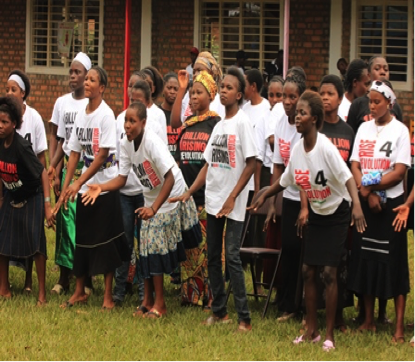
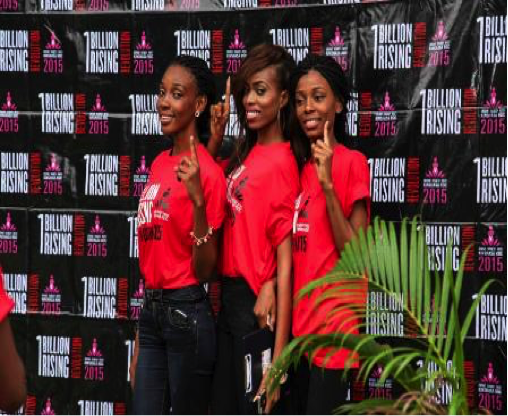
Introduction
This report seeks to explain the achievements of One Billion Rising Revolution of February 14, 2015. It justifies how Congolese can’t cease voicing their intolerance of violence through dance and drumming. It highlights how City of Joy residents, the staff, grassroots, activists in Bukavu and in Kinshasa and graduates from City of Joy stand for gender equity, human rights, gender justice, transitional justice, etc.
Last year, all over the world and in DRC, women took to the streets, went to schools, churches, and courthouses entitled to justice to rise and demand Justice on February 14, 2014. It was an opportunity for women and men who love them to come together in order to address publically the themes of justice through direct and shameless dance, songs, march, speeches, slogans, etc. The energetic mass actions of people who rose brought the demand to the forefront during the campaign and rising of February 14, 2014. Since February 2014, the energy that was accumulated from persistent, brave, and hero women and girls has been inspiring and bold.
The year 2015 was for the rising for revolution. When we asked Congolese women what revolution means, most of them said Revolution means transformation, change, or getting back their rights. In order to help the risers understand the role of dance and drumming in the campaign, residents of City of Joy who represent more than ten tribes of the Congo contacted their communities and relatives to know more about the meaning and importance of dance and drumming in their cultures. This year we have the Balega, the Batembo, the Bahunde, the Banyabwisha, the Lokele, the Bakusu, the Bangala, the Babembe, the Bafuliiru, the Bashi, the Banande, and the Bavira.
After they had collected the data, women shared the results in groups and most of them insisted on the fact that drums hold a special place and a deeper symbolic and historical meaning in their communities. For example, they said drums are always an accompaniment for any manner of ceremony – births, deaths, marriages, healing ceremonies, rites of passage, enthroning, ancestral worship, warrior rituals, as well as social dances. Drums can be used during full moon, harvesting time, baptisms, and countless other celebrations – together with a ritual dance. The vicious sound of many drums pounding together is also a necessary installment to stir up emotions in a battle or war to inspire excitement and passion.
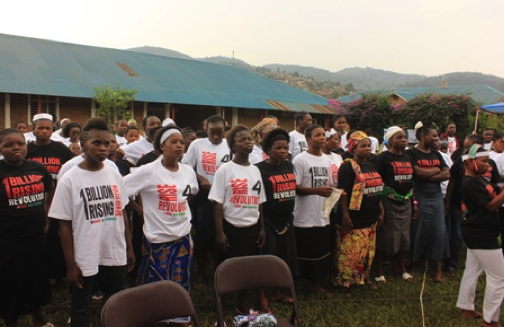
Answers to questions
Last year we rose for justice. We made campaign with the grassroots and they understood what justice looked like. The campaign ignited courage in them because they were all determined to demand transitional justice after they had experienced losses including the massacre of their friend and relatives. This year, people who saw us last year, were happy to see us renewing the call for revolution. They had promise to take action to change things which annihilate the development of women or things which are done with a view to violate human rights, especially women’s rights. The reaction of communities to the call for revolution was positive in such a way that OBR4R raised their awareness. It put them once more on their path to demand change.
The community of City of Joy with the graduates who works on the V-World Farm expressed themselves about how women should take their destiny in both hands and why they should keep on committing themselves to making change happen in their communities.
Of course it did. The conversation that was mostly deepened centered on the responsibility of the government towards justice. During the rising of this year, most of the issues which were raised dealt with who can facilitate transitional justice. For many, transitional justice is still a non-debated topic in the Congo. It is still theoretical. Campaigners need to sensitize more about the issue so that communities which are concerned with transitional justice may be well equipped and able to demand reparation for what was caused to them.
In the conversation, most of the interveners and participants insisted that Congolese women who were helped by the campaign to know what justice is will not keep quiet as long as the torment of war they endured remains unpunished. Congolese women and men who love them will always demand the institutionalization of the mechanisms of transitional justice.
During the risings, we wanted to hear from what the communities know about revolution and what the things which should be transformed are to make that revolution a reality. They pointed out such issues as:
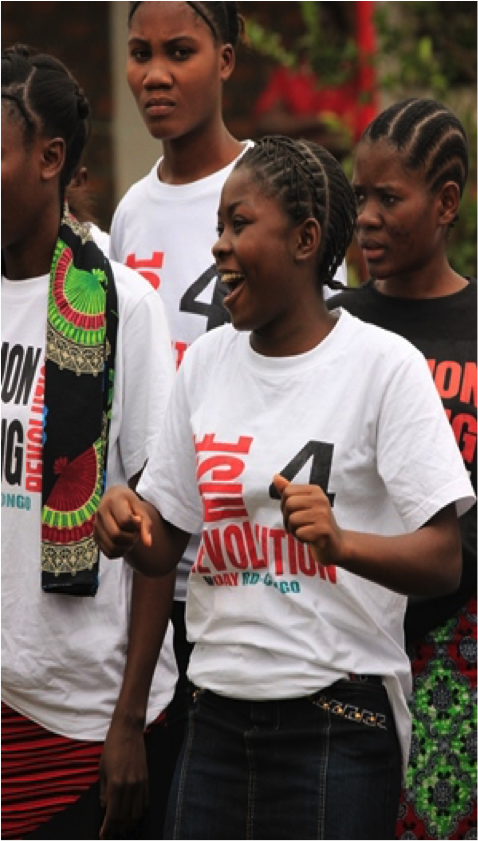
Events
As we planned, we had debates with the residents, grassroots and we invited activists and local leaders and some graduates to the rising of February 2015 in Bukavu. Our focal point in Kinshasa organized a press conference, sensitized communities and organizations to rise on March 6, 2015 in order to make the truth visible. All these events explained why V-DAY continues to rise against violence against women and girls and why women and men who love them should stand in solidarity against violence.
One Billion Rising Revolution in Kinshasa
Every year during the rising, we always wish to meet the power players in the region, we always make debate on the media to denounce the epidemic of violence in the Congo, and we always take to the streets with calicos, banners and other symbols to demand the end of impunity and forms of violence against women. This year, we faced challenges related to security. The whole period of OBR campaign, especially from November to date, people are arrested here and there. Students and activists are kidnapped at any time. Because of the lack of security, we were unable to march and to feel free to denounce cases of violence on the media as we planned. We could not even go to campaign in remote areas as we did last year for fear to be arrested during the pre-electoral campaigning activities.
Since we started the rising in 2013, we always hear the following from the risers, grassroots and activists:
Women and men learn from our campaign. In 2013 they learned about forms of violence which must be fought. In 2014 they got informed of what justice looks like and of the meaning and need for transitional justice. This year, they learned about the unending cycle of violence and the escalation of VDAY to contribute to its end. Women and gendered men need change. They need transformation in their communities at different levels; they want retrograde ways and customs to be revolutionized, they want leaders to promote gender equity and justice. Also, some participants to the rising committed themselves to bringing change from their home and inviting the others to do so.
As we said in supra, drums are instruments that when you hear them you feel something inside your body because they have this super natural power which goes into the body and touches our soul and wake our spirit. A drum beat is like a heartbeat. When you hear it, you are led and seduced to believe that they have the same pulse.
We drummed and danced on February 14, 2015. The aim was not only to share the drum spirit but also to create a community of risers who have a common vision. The dance created new energy and united people from different communities. We wanted to create a group of fighters who are called to make a revolution and a difference in our communities through dance and drumming. We wanted the drum bit and the songs to echo and spread the news of revolution. We wanted them to be the messengers to the neighborhood that revolution is needed in order to create a sane environment where women and men share equal opportunity.
Things that risers feared to denounce in their households and communities were made visible during the rising of February 14, 2015 in Bukavu and on Friday, March 6 in Kinshasa. In this way, dance made risers feel free and relieved and strong to tell the truth about what goes bad in communities.
We made a connection between the risings of 2013, 2014 and 2015. We made a recap on what One Billion Rising is. We involved activists and local leaders who played a key role during the outreach. Graduates from City of Joy were also invited to partake. All the ideas from associations and activists were capitalized and shared with people (men and women) who know about the rising. The day of February 14, 2015 was a day to dance and to denounce all forms of violence – economic, cultural, environmental, sexual, physical, etc. – that women are subjected to in their communities.
During the OBR we always have people /organizations who/which come to rise with us. This year, some activists who also fight against violence against women were by our side during the rising. They danced, rose, and drummed with us.
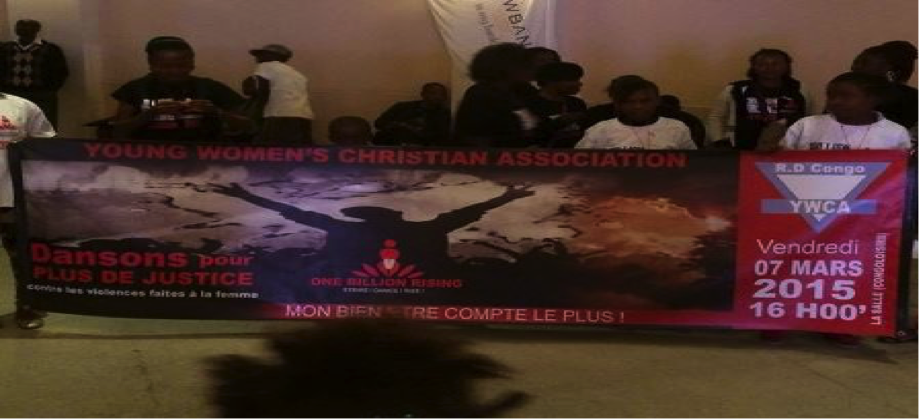
Done in Bukavu, March 18, 2015
VDAY CONGO